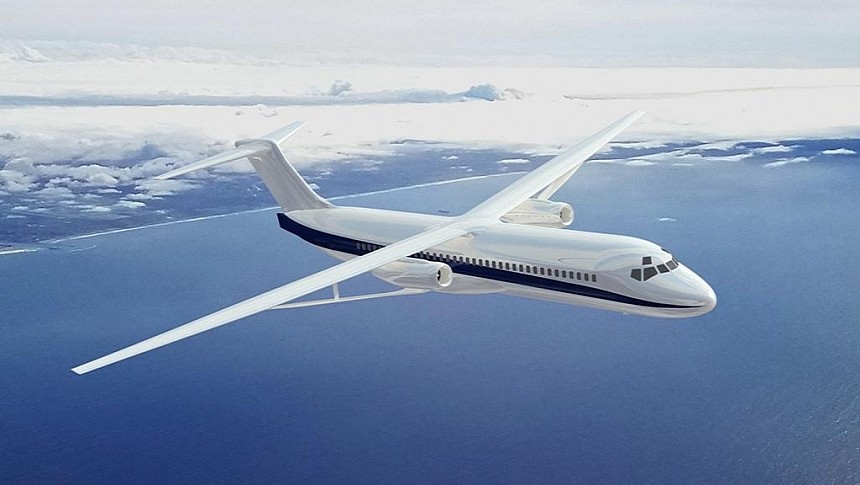It's been a very busy year for one of NASA's more daring aeronautical projects, one meant to find an innovative way to cut down airplane fuel consumption and emissions. So busy, in fact, that all the pieces seem to have fallen into place to allow the start of ground and flight tests by the end of the decade.
The project is centered around an aircraft the world now knows as the X-66A (aka Sustainable Flight Demonstrator). We learned back in August it will be a modified MD-90 single-aisle aircraft tasked with testing an important and potentially industry-changing piece of technology called Transonic Truss-Braced Wing (TTBW).
In essence, the TTBW is nothing more than extra real estate added on the outside of the plane. What that means is that the standard wing of the MD-90 will be elongated and made thinner, but will also be fitted with diagonal struts that will tie it to the main fuselage.
This wing extension if you will should allow the plane to generate a lot more lift, while requiring less fuel to do so. NASA hopes that this design, combined with a series of other technologies, will help bring down fuel consumption by as much as 30 percent.
Until now we knew little of what the other technologies will be, but we learned this week one of them will be the engines that power the MD-90.
Since Boeing is handling the conversion of the MD-90, the aerospace company announced who will be supplying the engines for the demonstrator: Pratt & Whitney. The hardware of choice for this application is the GTF (geared turbofan) family of engines.
This technology came about in 2016, and it is already deployed on a variety of airplanes, including the Airbus A220 and A320neo, or the Embraer E-Jets E2. Since its deployment, it has helped airlines cut down 1.4 billion gallons of their regular fuel usage, according to the company making them.
We are not told exactly what version of the GTF engine will make it into the X-66A and we don't know their exact capabilities. They will however be capable of running on sustainable aviation fuel (SAF).
The engines will be housed inside nacelles supplied by Collins Aerospace, and as such they should be 75 percent less noisy than the previous version of Pratt and Whitney engine family. The nacelles are made of composite and metallic materials and are supposed to offer protection to the powerplants, but also airflow control and reverse thrust capabilities.
At the time of writing, plans are to have the X-66A on the tarmac and in the air conducting test flights no sooner than 2028. It's unclear how much time NASA will need to prove the point it's trying to make, but if it does succeed the benefits for the aviation industry should be immense.
In essence, the TTBW is nothing more than extra real estate added on the outside of the plane. What that means is that the standard wing of the MD-90 will be elongated and made thinner, but will also be fitted with diagonal struts that will tie it to the main fuselage.
This wing extension if you will should allow the plane to generate a lot more lift, while requiring less fuel to do so. NASA hopes that this design, combined with a series of other technologies, will help bring down fuel consumption by as much as 30 percent.
Until now we knew little of what the other technologies will be, but we learned this week one of them will be the engines that power the MD-90.
Since Boeing is handling the conversion of the MD-90, the aerospace company announced who will be supplying the engines for the demonstrator: Pratt & Whitney. The hardware of choice for this application is the GTF (geared turbofan) family of engines.
This technology came about in 2016, and it is already deployed on a variety of airplanes, including the Airbus A220 and A320neo, or the Embraer E-Jets E2. Since its deployment, it has helped airlines cut down 1.4 billion gallons of their regular fuel usage, according to the company making them.
We are not told exactly what version of the GTF engine will make it into the X-66A and we don't know their exact capabilities. They will however be capable of running on sustainable aviation fuel (SAF).
The engines will be housed inside nacelles supplied by Collins Aerospace, and as such they should be 75 percent less noisy than the previous version of Pratt and Whitney engine family. The nacelles are made of composite and metallic materials and are supposed to offer protection to the powerplants, but also airflow control and reverse thrust capabilities.
At the time of writing, plans are to have the X-66A on the tarmac and in the air conducting test flights no sooner than 2028. It's unclear how much time NASA will need to prove the point it's trying to make, but if it does succeed the benefits for the aviation industry should be immense.










